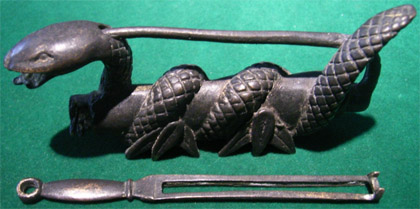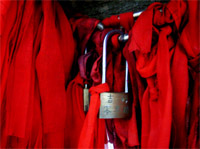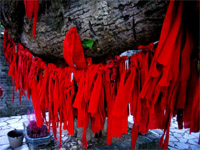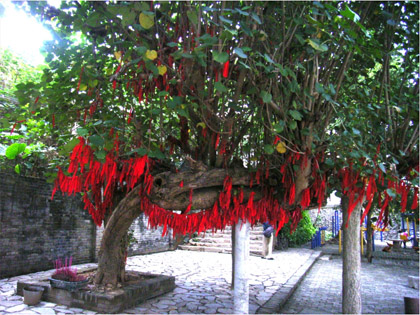Even today, there are many people in China who believe firmly in destiny and astrology. Some padlocks have a great symbolic value and are used as good luck charms.
In Chinese astrology, each year is symbolized by one of twelve zodiac animals; a person can be born in the year of the Dragon – the only mythological beast – the Rat, Ox, Tiger, Rabbit, Snake, Horse, Goat, Monkey, Rooster, Dog or Pig. This means, of course, that it takes twelve years to go full circle. Your animal of the zodiac is believed to characterize your personality.
 |
| Example of a padlock in the shape of an animal of the zodiac: the Snake. Photo by the author. |
 |
 |
| Examples of padlocks in the shape of animals of the zodiac: Dog, Monkey, Rat, Rooster, Ox, Horse |
Padlocks as “wedding locks”. In some places in China, a happy and lasting marriage is ensured using an ancient tree, a padlock and red ribbons. The bridal couple locks the ribbons onto the tree with a padlock engraved with their names and throws the key into a nearby waterway, locking the ties of love forever.
At the Great Wall of China, near Beijing, those who want to believe in a happily ever after have their names engraved on a little padlock, which they hang on a heavy chain or wear on a necklace and throw away the key somewhere along the wall.
In Moscow there is a wrought iron tree designed for the same type of ceremony, and a similar idea or tradition has arisen in Italy based on a novel by Frederico Mocca. He described a young couple who wrote their names on a padlock and fastened it to a bridge in Rome, throwing the keys in the river. The lock bore an inscription that their love would never die. The tradition caught on, and many bridges in Italian cities now have locks hanging on them.
 |
 |
 |
Pictures from a “wedding tree” in the old Ming city of Yangmeizhan,
30 km NE of Nanning in Southern China. Photos by the author. |